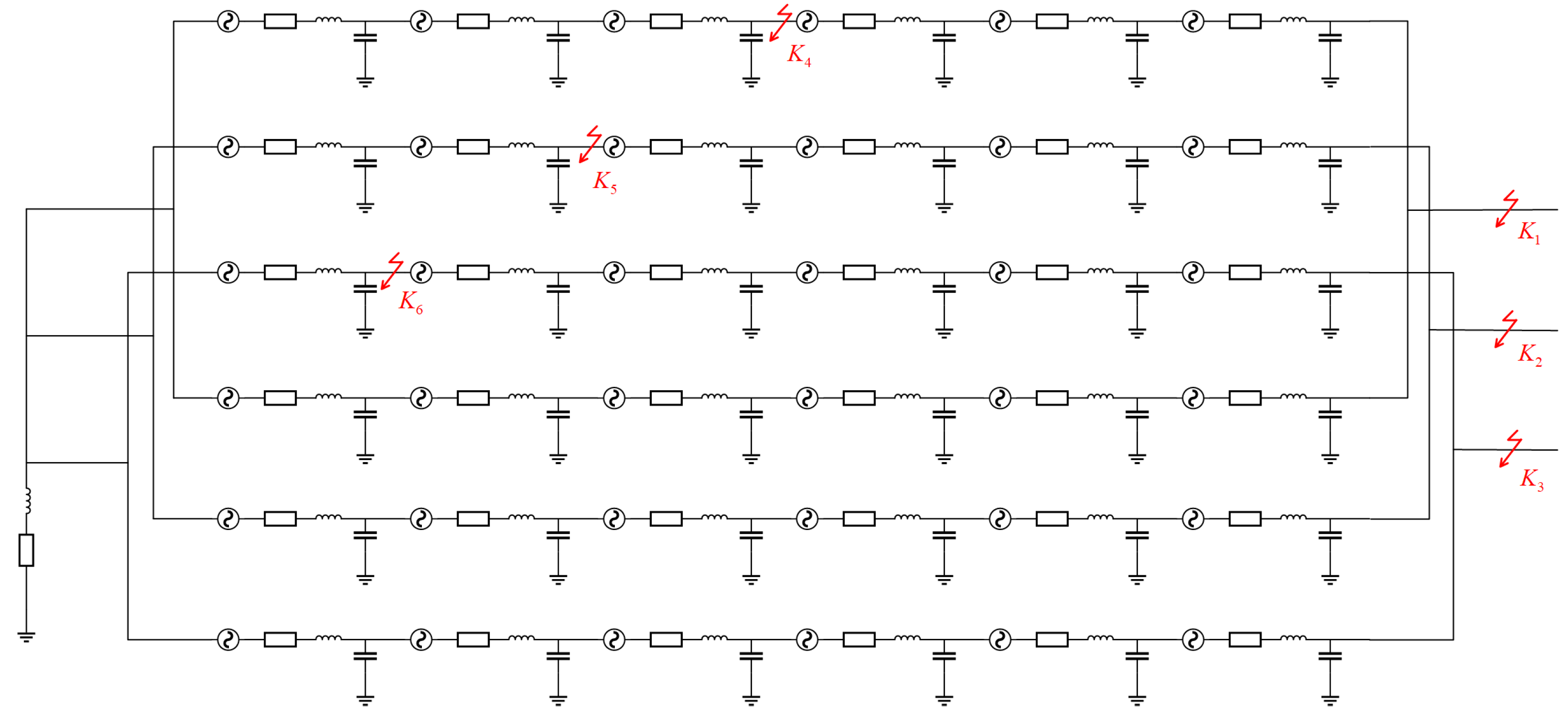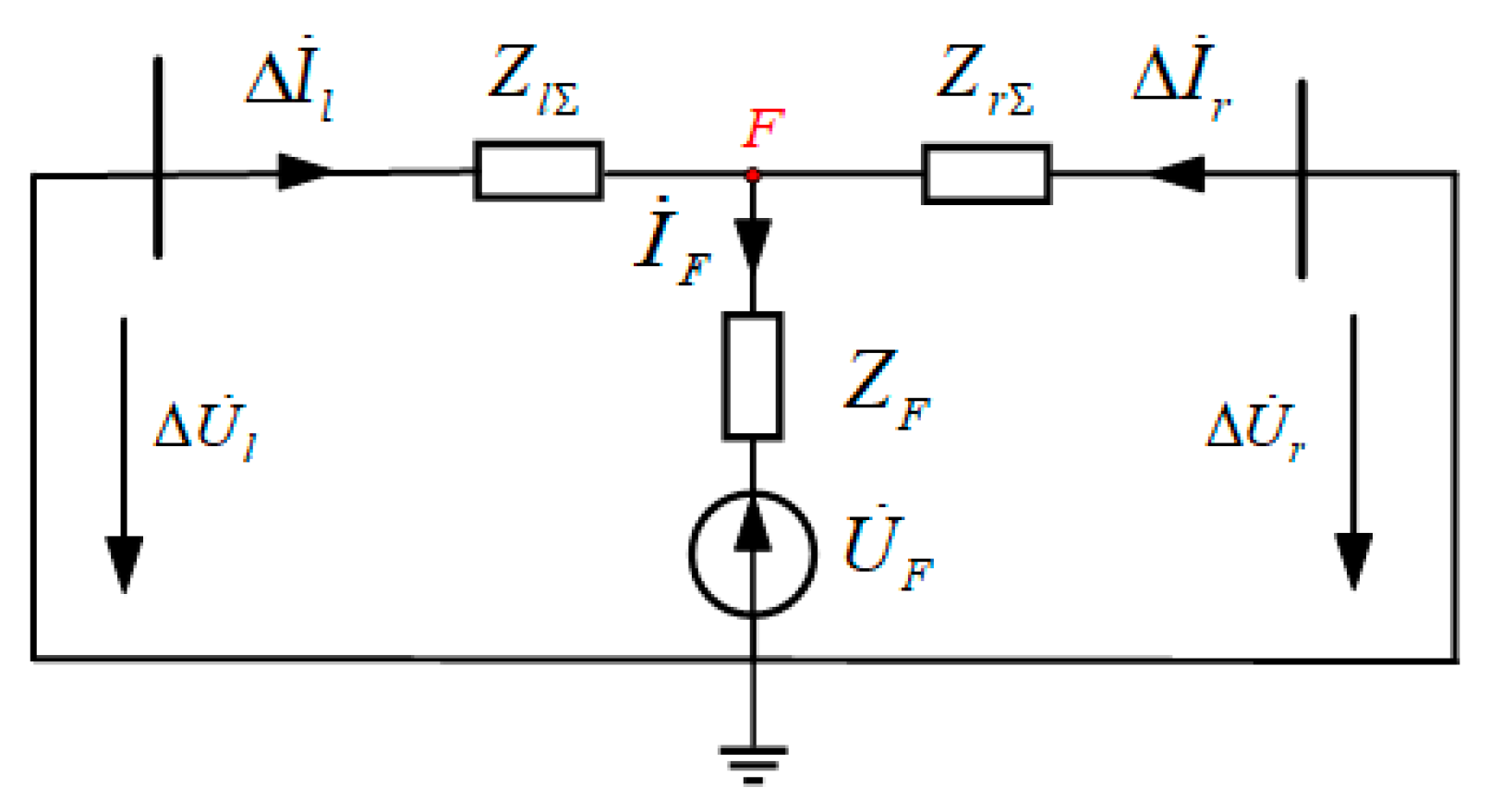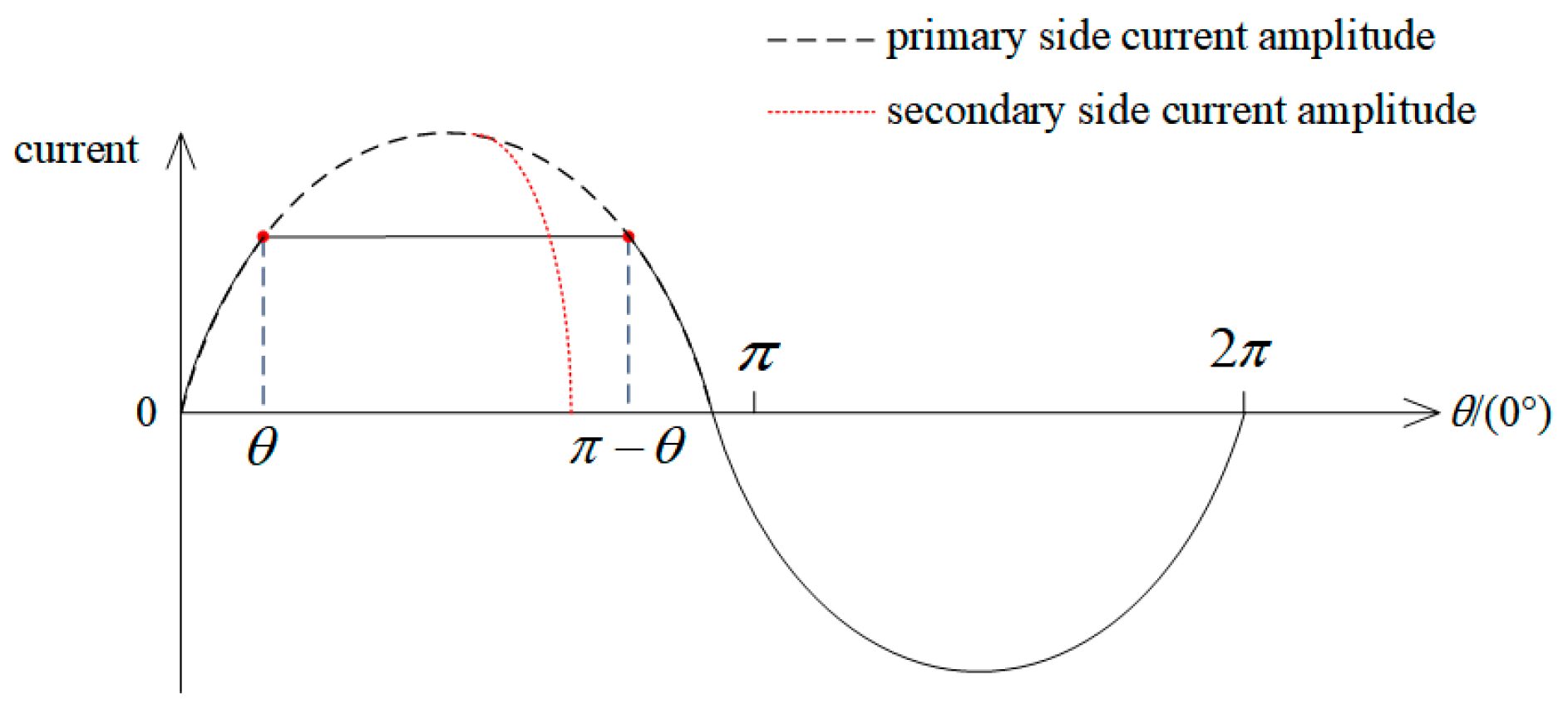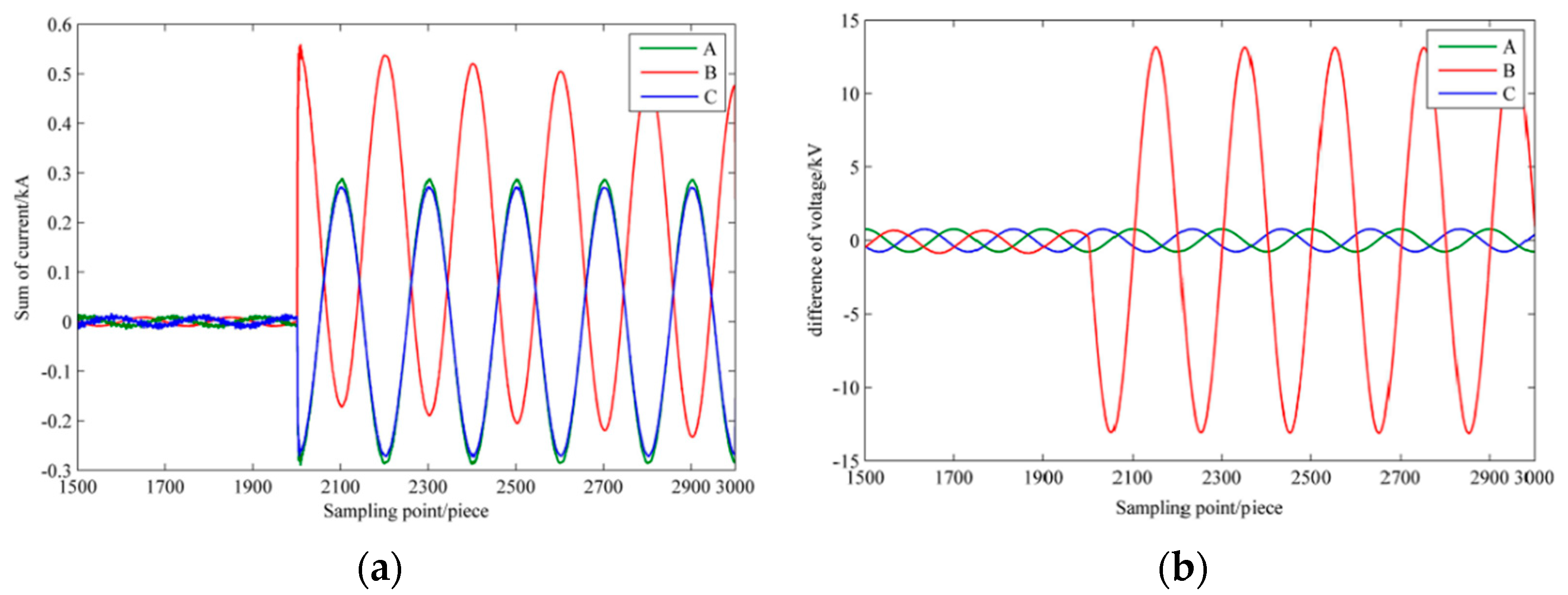Research on Differential Protection of Generator Based on New Braking Mode
Abstract
:1. Introduction
2. Improved Decoupling Method of Generator Stator Winding
3. Improved Algorithm of Generator Differential Protection
3.1. Ratio Braking Differential Protection
3.2. Differential Protection Algorithm Based on Longitudinal Impedance
3.2.1. External Fault
3.2.2. Internal Fault
3.2.3. Generator Differential Protection Algorithm Based on Longitudinal Impedance
3.3. The Effect of Transition Resistance under Transient Conditions
4. Performance Analysis
Anti-Current Transformer Saturation Capability
5. Simulation Verification
5.1. Digital Simulation
5.1.1. Simulation System and Its Parameters
5.1.2. Simulation Results and Analysis
5.2. Dynamic Experiments
5.2.1. Experiment System and Its Parameters
5.2.2. Experiment Results and Analysis
6. Conclusions
Author Contributions
Funding
Conflicts of Interest
Appendix A

References
- Kenichi, K.; Yutaka, O.; Akihiko, Y.; Kazuyuki, T. Novel Dynamic Voltage Support Capability of Photovoltaic Systems for Improvement of Short-Term Voltage Stability in Power Systems. IEEE Trans. Power. Syst. 2017, 32, 1796–1804. [Google Scholar]
- Seye, H.; Jacob, Ø. Control of Energy Storage for Increasing the PV Hosting Capacity of LV Grids. IEEE Trans. Indus. Smart Grid. 2018, 9, 2295–2303. [Google Scholar]
- Karthik, D.; Raghu, S.; Thanga, R. Control of Reactive Power for Stabilized Junction Temperature in Power Electronic Devices Serving to a 250-MW Asynchronous Hydrogenerating Unit. IEEE Trans. Indus. 2019, 55, 7854–7867. [Google Scholar]
- Farnaz, H.; Marcelo, S. Enhanced Instantaneous Power Theory Decomposition for Power Quality Smart Converter Applications. IEEE Trans. Power Elect. 2018, 33, 9344–9359. [Google Scholar]
- Mehdi, T.; Mehdi, A.; Ebrahim, F.; Hadi, G. An Efficient Structure of Marx Generator Using Buck–Boost Converter. IEEE Trans. Plasma Sci. 2018, 46, 117–126. [Google Scholar]
- Wang, M.; Sun, M.; Huang, Z.; Mu, S. Analysis of Stator Internal Phase-to-Phase Short Circuit in the 12-Phase Synchronous Generator with Rectifier-Load System. IEEE Trans. Energy Conv. 2018, 33, 299–311. [Google Scholar] [CrossRef]
- Zarei, M.; Platero, C.; Nicolás, C.; Arribas, J. Novel Differential Protection Technique for Doubly Fed Induction Machines. IEEE Trans. Indus. Appl. 2019, 55, 3697–3706. [Google Scholar] [CrossRef]
- Tang, J.; Chen, J.; Dong, K.; Yang, Y.; Lv, H.; Liu, Z. Modeling and Evaluation of Stator and Rotor Faults for Induction Motors. Energies 2020, 13, 133. [Google Scholar] [CrossRef] [Green Version]
- Pillai, P.; Bailey, B.; Bowen, J.; Dalke, G. Grounding and Ground Fault Protection of Multiple Generator Installations on Medium-Voltage Industrial and Commercial Power Systems-Part 3: Protection Methods Working Group Report. IEEE Trans. Indus. Appl. 2004, 40, 24–28. [Google Scholar] [CrossRef]
- Chen, X.; Liu, Z. Impedance Modeling and Stability Analysis of the Converters in a Double-Fed Induction Generator (DFIG)-Based System. Energies 2019, 12, 2500. [Google Scholar] [CrossRef] [Green Version]
- Shipp, D.; Pillai, P.; Bailey, B.; Mozine, C. Switching Transient Analysis and Specifications for Practical Hybrid High-Resistance Grounded Generator Applications—An IEEE/IAS Working Group Report #2. IEEE Trans. Indus. Appl. 2012, 48, 236–244. [Google Scholar]
- Safari-Shad, N.; Franklin, R.; Negahdari, A. Adaptive 100% Injection-Based Generator Stator Ground Fault Protection with Real-Time Fault Location Capability. IEEE Trans. Power Deliv. 2018, 33, 2364–2372. [Google Scholar] [CrossRef]
- Safari-Shad, N.; Franklin, R. Adaptive 100% Stator Ground Fault Protection Based on Third-Harmonic Differential Voltage Scheme. IEEE Trans. Power Deliv. 2016, 31, 1429–1436. [Google Scholar] [CrossRef]
- Zhu, Y.; Li, Y.; Sang, J.; Bao, M.; Zang, H. Analysis and Improvement of Adaptive Coefficient Third Harmonic Voltage Differential Stator Grounding Protection. Energies 2018, 11, 1430. [Google Scholar] [CrossRef] [Green Version]
- Jaafari, K.; Negahdari, A.; Toliyat, H. Modeling and Experimental Verification of a 100% Stator Ground Fault Protection Based on Adaptive Third-Harmonic Differential Voltage Scheme for Synchronous Generators. IEEE Trans. Indus. Appl. 2017, 53, 3379–3386. [Google Scholar] [CrossRef]
- Gao, B.; Wei, W.; Zhang, L.; Chen, N.; Wu, Y.; Tang, Y. Differential Protection for an Outgoing Transformer of Large-Scale Doubly Fed Induction Generator-Based Wind Farms. Energies 2014, 7, 5566–5585. [Google Scholar] [CrossRef] [Green Version]
- Zheng, T.; Yang, X.; Guo, X.; Wang, X.; Zhang, C. Zero-Sequence Differential Current Protection Scheme for Converter Transformer Based on Waveform Correlation Analysis. Energies 2020, 13, 1814. [Google Scholar] [CrossRef] [Green Version]
- Platero, C.; Gyftakis, K.; Panagiotou, P. Scheme for Synchronous Machine Stator Turn-to-turn Protection. Inst. Eng. Tech. 2020, 14, 716–722. [Google Scholar] [CrossRef]
- Ge, B.; Xiao, S.; Lv, Y. Transient Current Study of Hydro-generator Stator Winding Internal Fault. J. Mot. Control. 2014, 18, 40–45. [Google Scholar]
- Zhang, J.; Cui, M.; He, Y. Parameters Identification of Equivalent Model of Permanent Magnet Synchronous Generator (PMSG) Wind Farm Based on Analysis of Trajectory Sensitivity. Energies 2020, 13, 4607. [Google Scholar] [CrossRef]
- Xia, J.; Suonan, J.; Zhang, Y. Improved Pilot Protection Based on Longitudinal Impedance of Decoupled Transmission Line. Electr. Power Autom. Equip. 2013, 33, 58–65. [Google Scholar]
- Dzafic, I.; Neisius, T.; Gilles, M. Three-phase Power Flow in Distribution Networks Using Fortescue Transformer. IEEE Trans. Power. Syst. 2013, 28, 1027–1034. [Google Scholar] [CrossRef]
- Li, Z.; Fu, Y.; Wang, L.; Wang, L.; Bao, W.; Chen, Y. The Analysis and Solution of Current Differential Protection Maloperation for Transmission Line with High Series Compensation Degree. Energies 2019, 12, 1639. [Google Scholar] [CrossRef] [Green Version]
- Touimi, K.; Benbouzid, M.; Chen, Z. Optimal Design of a Multibrid Permanent Magnet Generator for a Tidal Stream Turbine. Energies 2020, 13, 487. [Google Scholar] [CrossRef] [Green Version]
- Sun, G.; Yang, G.; Wang, Y.; Su, J. Unifified Fault-tolerant Control Strategy with Torque Ripple Compensation for Five-phase Permanent Magnet Synchronous Motor Based on Normal Decoupling. Energies 2019, 12, 1127. [Google Scholar] [CrossRef] [Green Version]
- Xu, K.; Fan, C. Single-circuit Fault Analysis of Partially Coupled Lines with Different Voltage Levels. Auto Electr. Power Syst. 2015, 39, 81–87. [Google Scholar]
- Fan, C.; Cai, H.; Yu, W. Application of Six-Sequence Fault Components in Fault Location for Joint Parallel Transmission Line. Tsinghua Sci. Tech. 2005, 10, 247–253. [Google Scholar] [CrossRef]
- Xia, D. Power System Analysis; China Electric Power Press: Beijing, China, 2011; pp. 170–201. [Google Scholar]












| Fault Location | Fault Type | Transition Resistance/Ω | Phase Sequence | Ir/A | Ires/A | IRES/A | Ksen1 | Ksen2 |
|---|---|---|---|---|---|---|---|---|
| K1 | Ag | 0 | A | 103.0 | 3433.3 | 11,445.5 | 0.03 | 0.009 |
| B | 17.3 | 76.2 | 3438.7 | 0.23 | 0.005 | |||
| C | 17.3 | 76.2 | 3438.7 | 0.23 | 0.005 | |||
| Ag | 100 | A | 18.4 | 223.1 | 816.5 | 0.08 | 0.023 | |
| B | 2.64 | 8.34 | 189.8 | 0.32 | 0.017 | |||
| C | 2.64 | 8.34 | 189.8 | 0.32 | 0.017 | |||
| K3 | Cg | 0 | A | 17.2 | 46.5 | 3416.4 | 0.37 | 0.005 |
| B | 17.2 | 46.5 | 3416.4 | 0.37 | 0.005 | |||
| C | 105.5 | 1757.8 | 13,174.3 | 0.06 | 0.008 | |||
| Cg | 100 | A | 5.39 | 12.9 | 215.8 | 0.42 | 0.025 | |
| B | 5.39 | 12.9 | 215.8 | 0.42 | 0.025 | |||
| C | 17.2 | 24.2 | 1146.3 | 0.71 | 0.015 | |||
| K5 | Bg | 0 | A | 11.6 | 17.4 | 2325.2 | 0.67 | 0.005 |
| B | 66,672.2 | 13,254.9 | 4375.95 | 5.03 | 15.23 | |||
| C | 11.6 | 17.4 | 2325.2 | 0.67 | 0.005 | |||
| Bg | 100 | A | 2.3 | 3.9 | 256.9 | 0.59 | 0.009 | |
| B | 8715.6 | 1241.52 | 523.8 | 7.02 | 16.63 | |||
| C | 2.3 | 3.9 | 256.9 | 0.59 | 0.009 |
| Fault Location | Fault Type | Transition Resistance/Ω | Phase Sequence | Ir/A | Ires/A | IRES/A | Ksen1 | Ksen2 |
|---|---|---|---|---|---|---|---|---|
| K2 | BC | 0 | B | 105.5 | 2637.3 | 15,662.9 | 0.04 | 0.006 |
| C | 105.5 | 2637.3 | 15,662.9 | 0.04 | 0.006 | |||
| BC | 100 | B | 43.0 | 716.5 | 4688.6 | 0.06 | 0.009 | |
| C | 43.0 | 716.5 | 4688.6 | 0.06 | 0.009 | |||
| K4 | AB | 0 | A | 67,309.3 | 8205.6 | 5593.5 | 8.18 | 12.1 |
| B | 18,604 | 2268 | 1546 | 8.18 | 12.1 | |||
| AB | 100 | A | 50,478.3 | 6678.8 | 4233.1 | 7.56 | 11.8 | |
| B | 50,478.3 | 6678.8 | 4233.1 | 7.56 | 11.8 |
| Fault Location | Fault Type | Transition Resistance/Ω | Saturation θ/(°) | Ir/A | Ires/A | Protection Action |
|---|---|---|---|---|---|---|
| K1 | Ag | 0 | 30 | 90 | 3191 | NO |
| 0 | 60 | 293 | 3191 | NO | ||
| 0 | 120 | 954 | 3191 | NO | ||
| 0 | 180 | 1069 | 3191 | NO | ||
| 100 | 30 | 75 | 2574 | NO | ||
| 100 | 60 | 235 | 2574 | NO | ||
| 100 | 120 | 761 | 2574 | NO | ||
| 100 | 180 | 809 | 2574 | NO |
| Fault Location | Fault Type | Transition Resistance/Ω | Phase Sequence | Ir/A | IRES/A | Ksen2 |
|---|---|---|---|---|---|---|
| K1 | Ag | 0 | A | 273.1 | 30,344.5 | 0.009 |
| B | 1.53 | 305.83 | 0.005 | |||
| C | 2.11 | 351.67 | 0.006 | |||
| Ag | 100 | A | 149.1 | 5140.38 | 0.029 | |
| B | 1.9 | 168.52 | 0.011 | |||
| C | 1.5 | 130.85 | 0.012 | |||
| K3 | Cg | 0 | A | 1.4 | 274.64 | 0.005 |
| B | 1.6 | 316.73 | 0.005 | |||
| C | 296.3 | 32,956.3 | 0.009 | |||
| Cg | 100 | A | 1.3 | 59.78 | 0.021 | |
| B | 1.2 | 56.42 | 0.021 | |||
| C | 155.3 | 5776.1 | 0.027 | |||
| K5 | Bg | 0 | A | 91.3 | 18,356.2 | 0.005 |
| B | 4145.5 | 216.93 | 19.11 | |||
| C | 95.5 | 19,563.6 | 0.008 | |||
| Bg | 100 | A | 94.1 | 13,442.4 | 0.007 | |
| B | 2311.3 | 121.37 | 19.45 | |||
| C | 93.2 | 13314.3 | 0.007 |
Publisher’s Note: MDPI stays neutral with regard to jurisdictional claims in published maps and institutional affiliations. |
© 2021 by the authors. Licensee MDPI, Basel, Switzerland. This article is an open access article distributed under the terms and conditions of the Creative Commons Attribution (CC BY) license (http://creativecommons.org/licenses/by/4.0/).
Share and Cite
Xia, J.; Li, S.; Gao, S.; Shao, W.; Song, G.; Chen, C. Research on Differential Protection of Generator Based on New Braking Mode. Energies 2021, 14, 1857. https://doi.org/10.3390/en14071857
Xia J, Li S, Gao S, Shao W, Song G, Chen C. Research on Differential Protection of Generator Based on New Braking Mode. Energies. 2021; 14(7):1857. https://doi.org/10.3390/en14071857
Chicago/Turabian StyleXia, Jingde, Shaozhuo Li, Shuping Gao, Wenquan Shao, Guobing Song, and Changjiang Chen. 2021. "Research on Differential Protection of Generator Based on New Braking Mode" Energies 14, no. 7: 1857. https://doi.org/10.3390/en14071857






